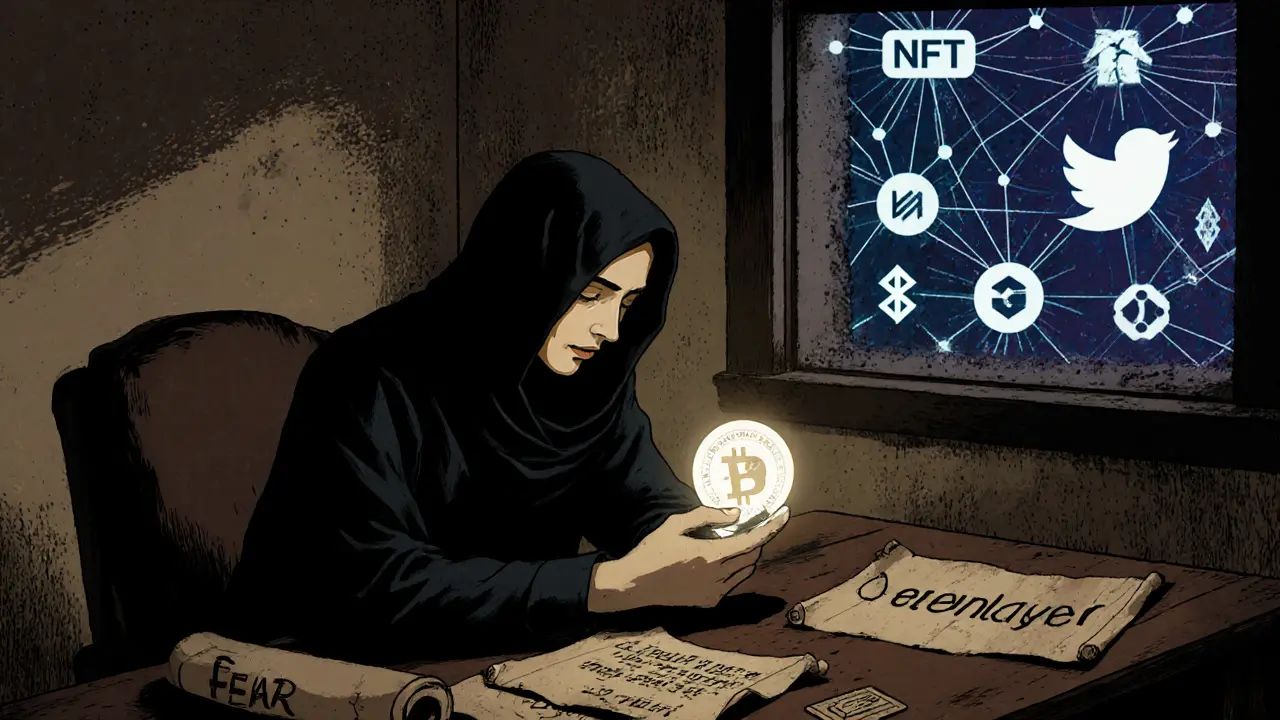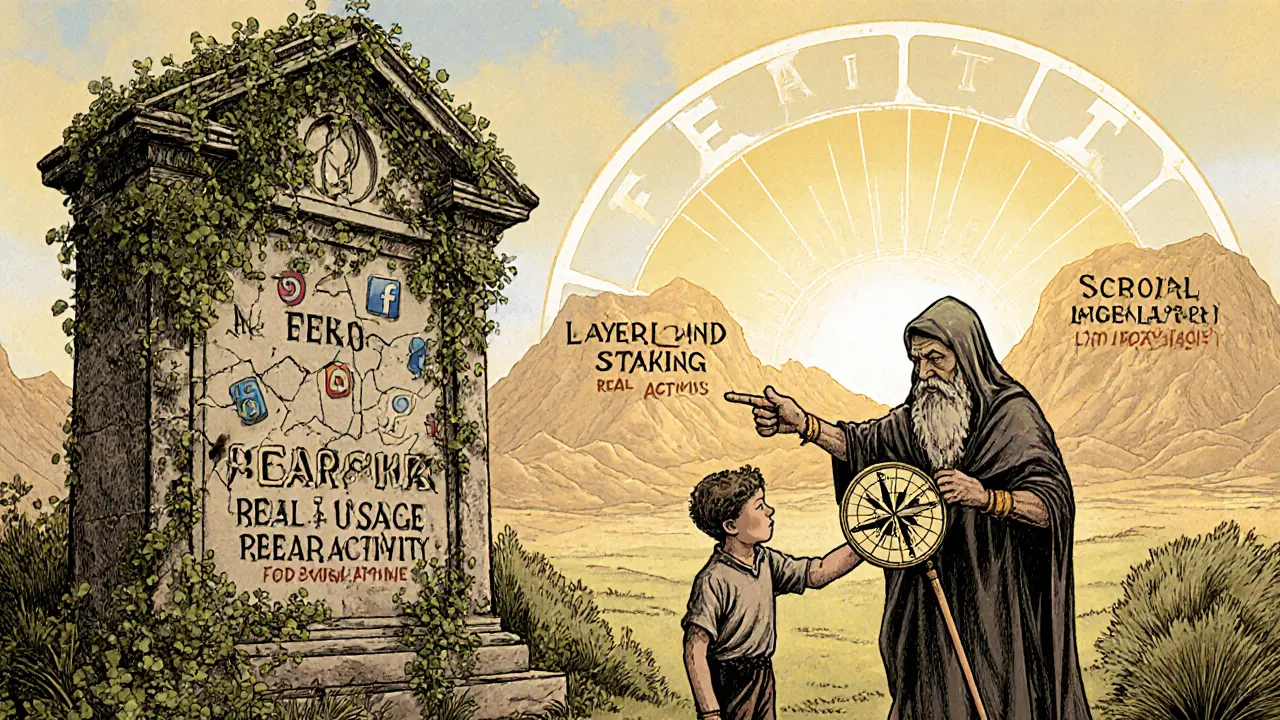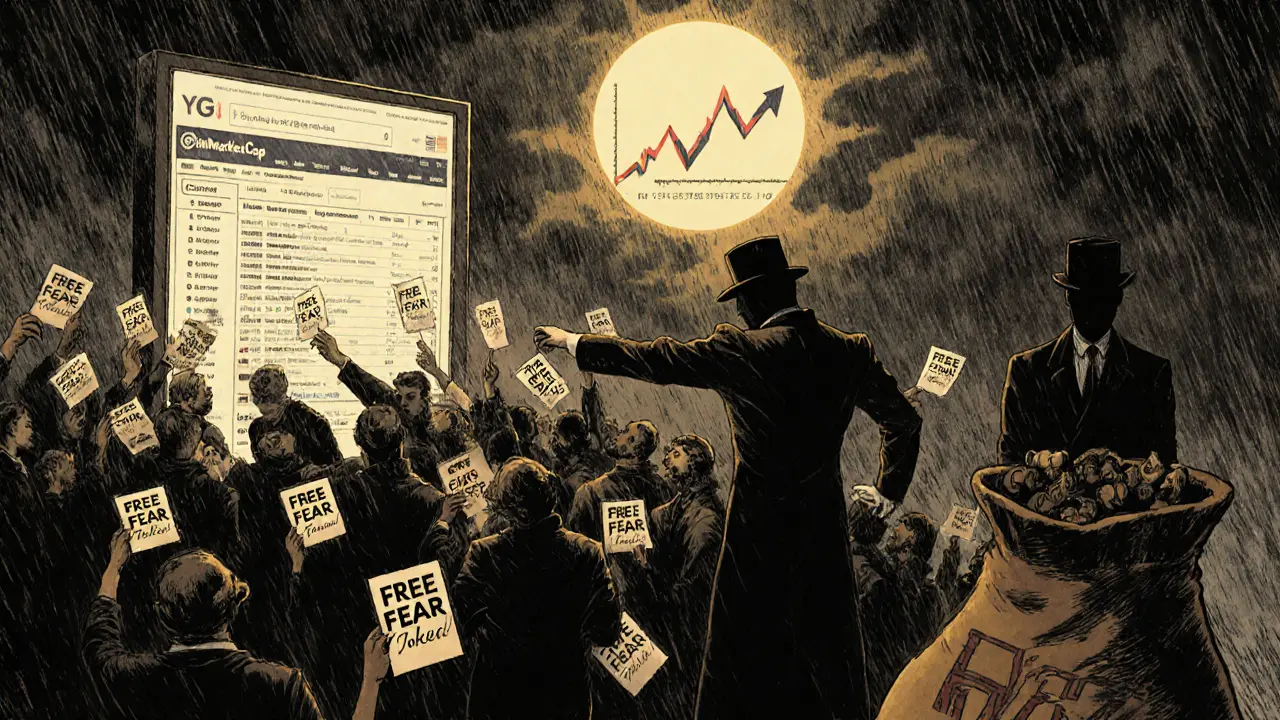FEAR Token Value Calculator
Calculate the value of your FEAR tokens if you participated in the 2021 airdrop. Based on the article, winners typically received around 40 tokens. This calculator shows how those tokens would have performed over time.
At Distribution
Estimated value at distribution (2021):
Based on early 2021 market conditions
At All-Time High
Value at all-time high (84% above current):
Before the token's value dropped
Current Value
Current value (October 2025):
Based on current market conditions
Back in 2021, if you were active on Twitter or Telegram and kept an eye on crypto airdrops, you probably saw the FEAR token pop up everywhere. It promised free tokens just for following accounts and signing up. Easy money, right? But here’s the truth: that airdrop is long over. And if you’re looking to claim FEAR tokens today, you can’t. Not because you missed the deadline - you didn’t miss anything. There’s nothing left to claim.
How the FEAR Token Airdrop Actually Worked
The FEAR token airdrop wasn’t run by some anonymous team hiding behind a whitepaper. It was hosted directly through CoinMarketCap, one of the biggest crypto data platforms with over 100 million users at the time. That gave it instant visibility. To join, you had to:- Have a CoinMarketCap account
- Follow FEAR’s official Twitter and Telegram channels
- Click the "Join This Airdrop" button on the CoinMarketCap page
Why the FEAR Airdrop Was Typical of Its Time
2021 was the peak of the "social media airdrop" era. Projects didn’t care if you used their product. They just wanted eyeballs. The goal wasn’t to build a community of users - it was to build hype. FEAR was part of the Play2Earn wave, riding the same trend as Axie Infinity and StepN. Everyone was chasing the next big gaming token. But here’s what made FEAR different: it didn’t actually have a game. No playable app. No in-game economy. No roadmap beyond "we’re building something." The token had no utility. No staking. No governance. No partnerships. Just a name, a Twitter account, and a CoinMarketCap listing. Compare that to today’s airdrops. Projects like EigenLayer reward users who stake ETH and contribute to network security. Scroll Network gives tokens to people who used their Layer 2 for actual transactions. Best Wallet Token tracks wallet activity across multiple chains. Modern airdrops measure real usage. FEAR measured likes and follows.What’s the FEAR Token Worth Today?
As of October 2025, FEAR is trading at $0.008443. That’s about 84% below its all-time high. Price forecasts for 2025 range between $0.0067 and $0.0093. For 2028, some models predict it might hit $0.0112 - but that’s still less than a 30% increase from today’s price. That’s not growth. That’s stagnation. The token’s market cap is tiny - under $2 million. It doesn’t trade on major exchanges like Binance or Coinbase. You can only find it on small, low-volume decentralized exchanges. Liquidity is thin. If you bought FEAR today, you’d struggle to sell it without crashing the price. And here’s the kicker: no one’s talking about it. No major crypto news site mentions FEAR. No YouTube influencers are doing deep dives. No Reddit threads are buzzing. The project hasn’t released a major update since 2022. Its website is static. Its Twitter account hasn’t posted since mid-2023.
Why You Shouldn’t Chase FEAR Tokens Now
If you’re reading this in 2025 and thinking, "Maybe I can still get some FEAR tokens," stop. There’s no active airdrop. No new distribution. No claim portal. The CoinMarketCap page is archived. The official links are dead. Even if you find someone selling FEAR tokens on a marketplace, you’re buying a dead asset. There’s no team behind it. No development. No roadmap. No reason for the price to go up. You’re not investing - you’re gambling on a ghost. This isn’t like buying Bitcoin in 2012. FEAR never had the foundation to survive the crypto winter. It didn’t build a product. It didn’t retain users. It didn’t adapt. It was a flash in the pan - a product of a time when hype was enough.What FEAR Teaches Us About Modern Airdrops
The FEAR token airdrop is a case study in what not to do. It shows how easy it was to trick people into thinking a token had value just because it was "free." But the market has changed. Today’s successful airdrops don’t reward social media followers. They reward real contributors. Projects now use:- Soulbound Tokens to prove you’re not a bot
- Multi-chain activity tracking to ensure you’re active across ecosystems
- Point systems based on usage, not just signing up
- Know Your Customer (KYC) checks to comply with regulations

What to Do Instead of Chasing Old Airdrops
If you want to benefit from crypto airdrops today, focus on projects that:- Have active development teams and public GitHub commits
- Require actual usage - like swapping tokens, bridging chains, or using dApps
- Are listed on reputable platforms like CoinGecko, Dune Analytics, or DefiLlama
- Have clear tokenomics and utility beyond speculation
Final Thoughts: FEAR Is a Reminder, Not an Opportunity
The FEAR token airdrop didn’t fail because of bad luck. It failed because it had no substance. It was built on noise, not value. And in crypto, noise fades fast. Today’s market doesn’t reward hype. It rewards execution. FEAR is gone. But the lesson it left behind? That’s still alive. Don’t chase free tokens. Chase real projects. Build real habits. And never forget: if it sounds too easy, it probably is.Can I still claim FEAR tokens from the 2021 airdrop?
No. The FEAR token airdrop ended in September 2021. The CoinMarketCap page is archived, and no claim portal exists anymore. Even if you participated back then, the tokens were distributed once and never reissued. There is no way to claim FEAR tokens today.
Is FEAR token worth buying now?
Not really. FEAR trades at around $0.0084 as of late 2025, with minimal volume and no active development. Price forecasts show only tiny potential gains over the next few years. There’s no utility, no team updates, and no exchange listings beyond obscure DEXs. Buying FEAR now is speculative at best and a loss of capital at worst.
Why did FEAR’s airdrop use CoinMarketCap?
CoinMarketCap had over 100 million monthly users in 2021, making it the easiest way to reach a large audience without building your own platform. By partnering with them, FEAR avoided the technical complexity of managing wallet snapshots or smart contracts. It was a quick, low-effort way to distribute tokens - but also a sign that the project had no long-term infrastructure plan.
Did FEAR have a real game or product?
No. FEAR was marketed as a Play2Earn token, but no playable game was ever released. There were no in-game assets, no economy, and no user interactions tied to the token. The NFT tickets distributed in the early airdrop were just digital collectibles with no functionality. Without a product, the token had no reason to hold value beyond speculation.
How do modern airdrops differ from FEAR’s?
Modern airdrops reward real usage, not social media activity. Projects like EigenLayer track staking activity. Scroll rewards users who transact on their Layer 2 network. They use Soulbound Tokens to prevent fraud and require multi-chain engagement. FEAR asked you to follow Twitter. Today’s airdrops ask you to build, use, and contribute - and they verify it with blockchain data.

bob marley
November 2, 2025 AT 16:40Let me guess - you still have a screenshot of your FEAR airdrop confirmation from 2021 and you keep it in your crypto shrine next to your CryptoKitties and your 2017 ICO whitepaper. Pathetic.
Jeremy Jaramillo
November 4, 2025 AT 10:19FEAR was a textbook example of how not to build anything real. It didn’t fail because the market turned - it failed because it was never built to begin with. No product, no team, no vision. Just a button you clicked while scrolling past ads.
Sammy Krigs
November 5, 2025 AT 23:51wait so u r saying if u followed a twitter acc in 2021 u got free tokens? but now its gone? so like… did they just… delete it? or did they steal it? i think this is a scam. they prob had a backdoor and took all the wallets. i saw this on a yt video.
David Roberts
November 6, 2025 AT 20:24The FEAR token’s collapse isn’t merely a cautionary tale - it’s a metaphysical indictment of the entire Web3 ethos in its infantile phase. When utility is replaced by performative participation - when the act of clicking becomes synonymous with contribution - we are no longer building ecosystems. We are curating digital theater. FEAR didn’t die because of regulatory pressure or technical failure. It died because it was never alive to begin with.
The market didn’t evolve. The participants did. And those who still chase ghosts like FEAR are clinging to the scaffolding of a cathedral that collapsed before it was consecrated.
Monty Tran
November 8, 2025 AT 01:28FEAR was a scam. End of story. No one cares anymore. Move on. Stop writing essays about dead tokens. You’re wasting everyone’s time.
Beth Devine
November 9, 2025 AT 07:01If you’re new to crypto and reading this, please take this as a lesson: free tokens are never free. Someone always pays - either with your time, your data, or your future capital. Don’t chase the next FEAR. Look for projects that show you their code, their commits, their team. Real work beats hype every time.
Brian McElfresh
November 10, 2025 AT 20:38They didn’t just kill FEAR - they buried it with a government contract. You think CoinMarketCap just let it go? Nah. They got paid to bury it. The whole thing was a pump-and-dump orchestrated by the Fed to scare small investors away from crypto. You think they want regular people owning assets? Please. This was a controlled demolition. FEAR was never meant to live. It was meant to be a warning.
And now they’re using the same playbook with Solana NFTs and Dogecoin 2.0. You’re being played. Wake up.
Hanna Kruizinga
November 11, 2025 AT 20:54Why are we even talking about this? It’s 2025. I forgot FEAR existed until I saw this post. I have better things to do than analyze dead airdrops. Like, I don’t even know what my phone password is anymore.
David James
November 12, 2025 AT 07:03Hey everyone - if you’re looking to get into airdrops today, start with things that actually require you to do stuff. Like use a wallet, swap a token, bridge a chain. Don’t just follow Twitter. That’s 2021 thinking. I started using Dune Analytics to track activity and now I’m getting real rewards. It’s not magic - it’s just smarter.
Shaunn Graves
November 12, 2025 AT 17:54So you wrote a 2000-word essay on a token worth less than a cup of coffee? Who gave you a platform? Did you get paid for this? Are you trying to monetize regret? This isn’t journalism. This is digital hoarding.
Jessica Hulst
November 14, 2025 AT 09:35There’s something deeply human about how we cling to the ghosts of failed promises - how we reread the emails, reopen the tabs, rewatch the YouTube videos from 2021 like they’re lost scriptures. FEAR didn’t die because it was bad - it died because we loved it too much to let it go. We didn’t invest in a token. We invested in the idea that maybe, just maybe, this time, it would be different. That maybe this time, the internet would give us something for nothing. And when it didn’t - we didn’t lose money. We lost innocence.
So yes, FEAR is dead. But the longing it left behind? That’s still alive. And that’s the real airdrop.
Kaela Coren
November 15, 2025 AT 21:44While the historical context of the FEAR token airdrop is undeniably illustrative of pre-2022 crypto marketing paradigms, it is also instructive to note that the absence of on-chain utility metrics, coupled with the lack of verifiable team identity, renders any post-hoc valuation attempt fundamentally speculative. The token’s current market depth is insufficient to support even minimal liquidity provision, and its residual value is entirely contingent upon the existence of non-rational actors.
Nabil ben Salah Nasri
November 17, 2025 AT 12:54Man I remember when I got my 40 FEAR tokens 😭 I thought I was rich. Now I just use them as wallpaper on my crypto tracker app. It’s like a digital memorial. But hey - at least I didn’t buy more. 🙏🙏🙏
alvin Bachtiar
November 18, 2025 AT 13:13FEAR was the epitome of a degenerate, zero-signal, social-engineering scam dressed up as innovation. It didn’t have a whitepaper - it had a fucking tweet. The entire project was a honeypot for retards who thought ‘follow and get rich’ was a viable financial strategy. And now? It’s a $2M ghost town with more dead links than a 2014 Bitcoin forum. Congrats, FEAR. You won the award for Most Useless Token of the Decade. 🏆
Josh Serum
November 19, 2025 AT 17:47Look, I know it’s tempting to think ‘maybe I missed out’ - but trust me, you didn’t. FEAR was trash. Even if you got the tokens, you’d be holding garbage. Don’t fall for the FOMO trap. Real projects don’t need you to follow them on Twitter. They need you to use them. And if they don’t have a working product? Walk away. Seriously.
DeeDee Kallam
November 19, 2025 AT 21:43i think they stole our data and sold it to the feds or something idk i just know i got a weird email after the airdrop and now my credit score is trash and i think its all because of fear
Helen Hardman
November 20, 2025 AT 12:17Hey, I just want to say - if you’re still holding FEAR, I get it. I held onto my 2017 Ethereum Classic too. But here’s the thing: letting go doesn’t mean you lost. It means you chose to stop chasing ghosts and started building something real. I started staking on EigenLayer last year. I didn’t get rich, but I learned how the chain works. That’s worth more than any airdrop ever was.
You’re not behind. You’re just waking up. And that’s okay.
Bhavna Suri
November 21, 2025 AT 00:57Why do Americans care so much about free tokens? In India, we know if something is free, it is not real. We wait for real things. Like jobs. Like food. Like safety. This FEAR thing is just a game for rich people who have nothing better to do.